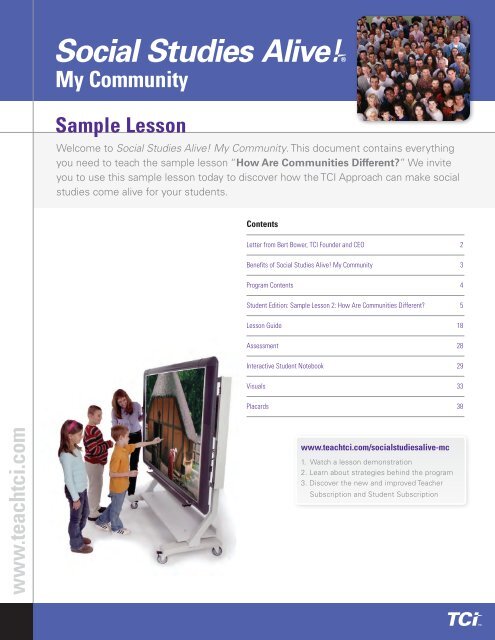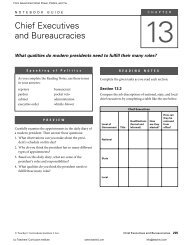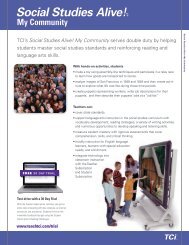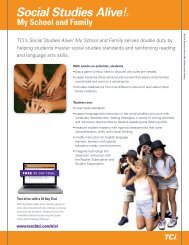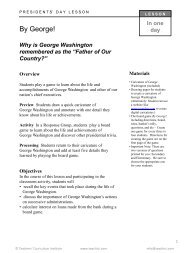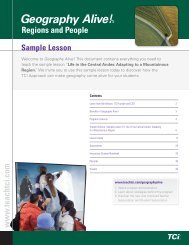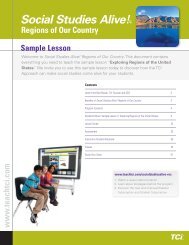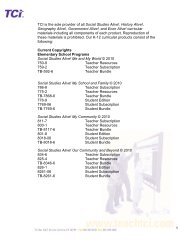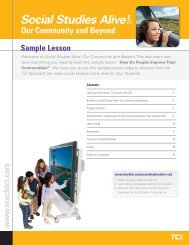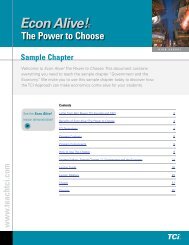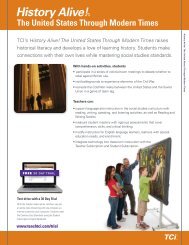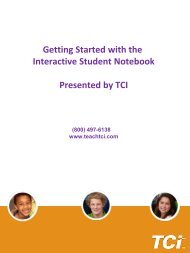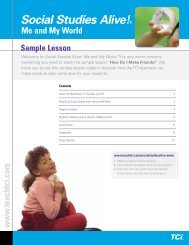Social Studies Alive! My Community | Sample Chapter | Social ... - TCI
Social Studies Alive! My Community | Sample Chapter | Social ... - TCI
Social Studies Alive! My Community | Sample Chapter | Social ... - TCI
You also want an ePaper? Increase the reach of your titles
YUMPU automatically turns print PDFs into web optimized ePapers that Google loves.
Welcome!<strong>Social</strong> <strong>Studies</strong> <strong>Alive</strong>! <strong>My</strong> School and FamilyYou have in your hands a sample of <strong>Social</strong> <strong>Studies</strong> <strong>Alive</strong>! <strong>My</strong> <strong>Community</strong>from <strong>TCI</strong>. This sample lesson is intended to give you the opportunity both toreview our program and to try it out in your own classroom so you can jointhe growing body of elementary teachers who are turning to <strong>Social</strong> <strong>Studies</strong><strong>Alive</strong>! to reinvigorate their social studies and language arts programs.As a high school teacher who teaches only one subject, I am in awe ofelementary teachers. You not only teach all subjects—math, language arts,science, and social studies—you juggle a myriad of other teaching and nonteachingresponsibilities as well. That’s why we created <strong>Social</strong> <strong>Studies</strong> <strong>Alive</strong>!<strong>My</strong> <strong>Community</strong>—to make it easier for you to integrate language arts skillsand social studies skills, to create active lessons to keep kids engaged, andto provide meaningful content to inspire young learners to care about theworld around them.I’m confident you and your students will enjoy this sample lesson. I lookforward to welcoming you to the <strong>TCI</strong> community of inspired, active socialstudies teachers!welcomeBest,Bert Bower, <strong>TCI</strong> Founder and CEO2
www.teachtci.comBenefits of <strong>Social</strong> <strong>Studies</strong> <strong>Alive</strong>!<strong>My</strong> <strong>Community</strong>How can we help our students tounderstand their world? How do weprepare them to participate in it effectively?To these core social studies goals, <strong>TCI</strong> addsanother: How do we get students excitedabout this learning? <strong>Social</strong> <strong>Studies</strong> <strong>Alive</strong>!<strong>My</strong> <strong>Community</strong> delivers on all three goals.Interactive classroom experiences, coupledwith fascinating reading, engage all learnersin today’s diverse classroom.<strong>TCI</strong> recognizes the challenge to teachers offitting social studies into a school day thatmust concentrate so heavily on the threeR’s. To meet this challenge, <strong>TCI</strong> has createda social studies program that serves doubleduty: reinforcing reading and language artsskills at the same time that students learnsocial studies.<strong>Studies</strong> <strong>Alive</strong>! <strong>My</strong> <strong>Community</strong> was createdby teachers, for teachers. The program isflexible and easy to use, providing a varietyof ways to meet student needs.Teachers can• Cover state standards in history,geography, economics, and government.• motivate student reading with theReading Further feature in each chapter—a high-interest case study that drills downinto interesting events, concepts, andpeople discussed in the chapter.• support language arts instruction in thesocial studies curriculum with vocabularydevelopment, reading strategies, a varietyof writing activities, and numerousopportunities to develop speaking andlistening skills.• Measure student mastery with rigorousassessments that cover comprehension,skills, and critical thinking.• modify instruction for English languagelearners, learners with special educationneeds, and enrichment.• extend learning with recommendedadditional reading opportunities and <strong>TCI</strong>’sonline Enrichment Resources, includinga Biography Bank and EnrichmentReadings.<strong>Studies</strong> <strong>Alive</strong>! <strong>My</strong> <strong>Community</strong> will helpyou ignite your students’ passion forlearning social studies and your passionfor teaching it!<strong>Social</strong> <strong>Studies</strong> <strong>Alive</strong>! <strong>My</strong> School and Family3
Program Contents1 What Is a <strong>Community</strong>?2 How Are Communities Different?3 How Do We Use Maps?4 What Is Geography?5 How Do People Use Our Environment?6 How Are Goods Made and Broughtto Us?<strong>Social</strong> <strong>Studies</strong> <strong>Alive</strong>! <strong>My</strong> School and FamilyIn <strong>Social</strong> <strong>Studies</strong> <strong>Alive</strong>! <strong>My</strong><strong>Community</strong>, an EssentialQuestion organizes each lessonand its corresponding activity.By reading the Student Editionand participating in the classroomactivity, students gaina deeper understanding ofthe content.7 Who Provides Services in a<strong>Community</strong>?8 How Can I Be a Good Shopper?9 How Do Communities Change?10 How Did One <strong>Community</strong> Change?11 How Can One Person Makea Difference in a <strong>Community</strong>?12 How Do Leaders Help TheirCommunities?13 What Does a Good Citizen Do?14 What Do Communities Share?<strong>Sample</strong> Lesson:2 How Are Communities Different?FREE 30 DAY TRIALcontentsTest-drive with a 30 Day TrialWith the Teacher Subscription, teachers can get anentire class interacting with one computer, an internetconnection and a projector. Students thrive on theimmediate feedback they get using the StudentSubscription’s Reading Challenges.www.teachtci.com/trial4
| Student Edition | Lesson Guide | Lesson Masters | Interactive Student Notebook | Visuals | Placards6
How AreCommunitiesDifferent?Communities come indifferent sizes. In thischapter, you will learn aboutthree kinds of communities.They are called urban, rural,and suburban.2| Student Edition | Lesson Guide | Lesson Masters | Interactive Student Notebook | Visuals | Placards7
| Student Edition | Lesson Guide | Lesson Masters | Interactive Student Notebook | Visuals | Placards82.1 Cities Are Urban CommunitiesCities have lots of buildings and people.People often walk from place to place in acity. Sometimes they take a bus or a taxi.Many people ride trains from one part of acity to another. Some people drive cars.Many people live in apartments in cities.One apartment building might have 50 ormore homes. Have you ever been to a city?
2.2 Living in Urban CommunitiesCities are exciting. There are many storesand restaurants in a city. There are parks,playgrounds, and museums.Sometimes, cities are noisy. Cars honktheir horns. People sing. Babies cry.Dogs bark.There are crowds in a city. There arelots of people on the sidewalks. Stores andrestaurants are busy places, too. What doyou like about cities?| Student Edition | Lesson Guide | Lesson Masters | Interactive Student Notebook | Visuals | Placards9
2.3 Small Towns Are RuralCommunitiesSmall towns are in the countryside. Theyare far from cities.Small towns have fewer people thancities. Many people know their neighborswell in a small town.Small towns might have just one store.There may be a post office, a bank, and aschool. Do you live in a small town?| Student Edition | Lesson Guide | Lesson Masters | Interactive Student Notebook | Visuals | Placards1016
| Student Edition | Lesson Guide | Lesson Masters | Interactive Student Notebook | Visuals | Placards112.4 Living in Rural CommunitiesMany people live and work on farms inrural communities. They drive to the storeand the post office. Students ride a busto school.There are different ways to have fun in asmall town. In a city, you might visit a bigaquarium. In a small town, you might gofishing. What things would you like to doin a small town?
2.5 Communities Outside CitiesAre SuburbsSuburbs are smaller communities justoutside of cities. Many people live insuburbs. Suburbs have many kinds ofhomes. They have schools, fire stations,police stations, and hospitals.Suburbs have stores and gas stations.They have parks and other places to play.Do you live in a suburb?| Student Edition | Lesson Guide | Lesson Masters | Interactive Student Notebook | Visuals | Placards1218
2.6 Living in SuburbanCommunitiesMany families live in suburbs. Somepeople live in houses. Some people live inapartments. Lots of homes have yards.Most people drive cars in a suburb.People drive to work. They drive toshopping malls. There are lots of parkinglots in suburbs. What else might you see ina suburb?| Student Edition | Lesson Guide | Lesson Masters | Interactive Student Notebook | Visuals | Placards13SummaryUrban communities are cities with many people.Rural communities are small towns far from cities.Suburban communities lie just outside of cities.
ReadingFurther2Instant SuburbsAbout 60 years ago, Bill Levitt had anidea. He wanted to build homes foryoung families. Thousands of homes!How did his new idea help form suburbsaround the country?Up and down the street, workers werebuilding new houses. They worked veryquickly. They could finish about thirtyhouses in a day. All the houses lookedalmost the same.The town was called Levittown,Pennsylvania. Hal and Sylvia Lefcourtbought one of the new houses. Sylvia wasso happy she cried. Hal said he alwaysdreamed of owning a house.| Student Edition | Lesson Guide | Assessment | Interactive Student Notebook | Visuals | Placards14This suburb usedto be farmland.
Levittowns were built near highways.People could drive easily to work in nearbycities.The houses were small and modern.Everything was new. Some homes camewith a recent invention—a TV!The houses had huge windows in theliving room. These big windows were called“picture windows.” Parents could watchtheir children playing outside.There were lots of children, too. Theyplayed in the backyards. Because no fenceswere allowed in Levittowns, children ranfrom yard to yard.| Student Edition | Lesson Guide | Assessment | Interactive Student Notebook | Visuals | Placards16Levittown houseslooked almostalike.
The Levitts also built playgrounds, stores,and community centers. They built wholetowns from start to finish.Some people did not like the Levittowns.They said everything looked the same.They did not like the rules the Levittsmade. Some rules said what you could doand not do to the houses. Other rules saidwho could buy houses and who could not.Still, the “instant suburbs” were popular.Other builders copied the Levitts’ ideasin new suburbs across the country. Later,people made changes to the Levitt houses,but the suburbs still exist today.Levittown houseslook very differenttoday.| Student Edition | Lesson Guide | Assessment | Interactive Student Notebook | Visuals | Placards17
P l a n n i n g G u i d eActivity Suggested Time MaterialsPreview• Connecting to PriorKnowledge• Developing Vocabulary• Building BackgroundKnowledgeVisual DiscoveryExamining shared and individualfeatures of urban, rural,and suburban communities20 minutes • <strong>Social</strong> <strong>Studies</strong> <strong>Alive</strong>! <strong>My</strong><strong>Community</strong>, Big Book, <strong>Chapter</strong> 2introduction• Transparency 2A• Placards 2A–2F• Interactive Student NotebooksPhase 130 minutes• Identifying features of urbancommunities (Steps 1–3)Phase 225 minutes• Comparing and contrastingurban and rural communitiesand identifying features of ruralcommunities (Steps 4–6)Phase 315 minutes• Identifying features of suburbancommunities (Steps 7 and 8)• <strong>Social</strong> <strong>Studies</strong> <strong>Alive</strong>! <strong>My</strong><strong>Community</strong>, Big Book and StudentEditions, <strong>Chapter</strong> 2 introduction andSections 2.1–2.6• Transparencies 2A–2D• Placards 2A and 2E• Interactive Student Notebooks• Student Handouts 2A and 2B (cutapart, 1 word per student)• paper strips, approximately 8 1/2” x2” (folded in thirds; 1 per student)| Student Edition | Lesson Guide | Assessment | Interactive Student Notebook | Visuals | Placards19Reading FurtherExploring the history of theLevittown suburbsProcessingCreating a human bar graphPhase 420 minutes• Comparing and contrastingthree types of communities(Steps 9–11)25 minutes • <strong>Social</strong> <strong>Studies</strong> <strong>Alive</strong>! <strong>My</strong><strong>Community</strong> Big Book and StudentEditions, <strong>Chapter</strong> 2 Reading Further• Transparency 2E• Interactive Student Notebooks• old magazines and newspapers30 minutes • Placards 2B, 2D, and 2F• Interactive Student NotebookAssessment 20 minutes • <strong>Chapter</strong> 2 Assessment
Preview1 Connecting to Prior Knowledge: Display pictures of the three types ofcommunities.• Randomly arrange Placard 2A: <strong>Community</strong> 1 through Placard 2F:<strong>Community</strong> 6 on the chalkboard tray or in a pocket chart.• Ask students to decide which two communities are most like each other.Place these placards side by side, and have students match the next two sets.• Invite students to compare and contrast the three sets of pictures. Encouragethem to point out community features that are the same or different.• Tell students that, in this lesson, they will learn about the three types ofcommunities they just saw.2 Developing Vocabulary: Introduce the key social studies terms—urban,rural, suburban, and suburb.• Discuss each term before beginning the activity, using methods describedin Solutions for Effective Instruction.• Review each term again with students as they appear in the activity readingand encourage them to use them in their own writing.3 Building Background Knowledge: Help students identify the features ofurban, rural, and suburban communities.• Use the opening illustration on <strong>Social</strong> <strong>Studies</strong> <strong>Alive</strong>! <strong>My</strong> <strong>Community</strong> BigBook pages 12 and 13 or project Transparency 2A: How Are CommunitiesDifferent? to introduce the new ideas: urban, rural, and suburban.• Talk about the way these communities form a “bulls-eye” pattern, with anurban center circled by suburbs that are surrounded by rural areas. Use anerasable marker to show the bulls-eye pattern on the transparency.• Have students identify features in the illustration that distinguish eachtype of community.• Have students complete Preview 2 in their Interactive Student Notebooks.Explain that they should label the urban, suburban, and rural drawings onthe page.<strong>Community</strong> 1<strong>Community</strong> 2How Are Communities Different?© Teachers’ Curriculum Institute <strong>Social</strong> <strong>Studies</strong> <strong>Alive</strong>! <strong>My</strong> <strong>Community</strong> 3Transparency 2AP r o c e d u r e sP l a c a r d 2 C<strong>Community</strong> 3P l a c a r d 2 BP l a c a r d 2 A© Teachers’ Curriculum Institute <strong>Social</strong> <strong>Studies</strong> <strong>Alive</strong>! <strong>My</strong> <strong>Community</strong> 3© Teachers’ Curriculum Institute <strong>Social</strong> <strong>Studies</strong> <strong>Alive</strong>! <strong>My</strong> <strong>Community</strong> 2© Teachers’ Curriculum Institute <strong>Social</strong> <strong>Studies</strong> <strong>Alive</strong>! <strong>My</strong> <strong>Community</strong> 1Placards 2A–2FT r a n s p a r e n c y 2 A| Student Edition | Lesson Guide | Assessment | Interactive Student Notebook | Visuals | Placards20Visual DiscoveryPhase 1: Urban Communities1 Help students identify features of urban communities.• Project Transparency 2B: An Urban <strong>Community</strong>. Ask: What do you see?What kinds of buildings are in the city? What do people do in these buildings?Where do you think these people are going? How do people move fromone place to another in the city?• Explain that this type of community is called an urban community. Thenread aloud the opening text and Sections 2.1 and 2.2 in the <strong>Social</strong> <strong>Studies</strong><strong>Alive</strong>! <strong>My</strong> <strong>Community</strong> Big Book. Have students follow along in theirStudent Editions.An Urban <strong>Community</strong>T r a n s p a r e n c y 2 B© Teachers’ Curriculum Institute <strong>Social</strong> <strong>Studies</strong> <strong>Alive</strong>! <strong>My</strong> <strong>Community</strong> 4Transparency 2BHow Are Communities Different? 13
P r o c e d u r e s• With Section 2.1, discuss what is found in an urban community.• With Section 2.2, discuss the advantages and disadvantages of living inthis type of community.2 Help students prepare to act out life in an urban community.• Tell students they will act out life in an urban community.• Prepare a three-column chart with these headings: Places to Work in anUrban <strong>Community</strong>, Places to Live and Stay in an Urban <strong>Community</strong>, andPlaces for Fun in an Urban <strong>Community</strong>.• Brainstorm with the class ideas for these three categories and record theirideas on the chart.• Distribute one strip of paper, folded into thirds, to each student. Have eachstudent draw three pictures showing a place to work, a place to live or stay,and a place to have fun in a city. The pictures will help them rememberthings they want to say during the act-it-out.• Before students begin drawing each picture, prompt them with questions.• For Picture 1, ask: If you are going to work, what do you do? Where doyou work? What tools do you need to do your job?• For Picture 2, ask: If you are living or staying in the city, what does yourbuilding look like? What do you do there? What do you see from yourbuilding?• For Picture 3, ask: If you are having fun in a city, where might you be?What does this place look like? What will you do there?• Encourage students to include as many details in their drawings as timeallows.3 Have students perform an act-it-out in groups of five.• Project Transparency 2B. Ask five students to stand in front of the transparencyand act as though they are some of the people in the crosswalk.• Interview the students about life in the city. Tell them they may use theirpictures to help them answer the questions. Repeat with other groups offive students until all students have acted in the scene.| Student Edition | Lesson Guide | Assessment | Interactive Student Notebook | Visuals | Placards21Phase 2: Urban and Rural Communities4 Help students compare urban and rural communities.• Project Transparency 2C: Urban and Rural Communities. Ask: What doyou see here? What kind of community is the one pictured on top? (urban)How are the buildings different in each community? Which community isless crowded? Which has more traffic? Which has more land? Which hasfarms? Which has fewer stores? Where would you see more animals?• Encourage students to explain their answers.5 Help students learn the features of rural communities.• Read aloud Sections 2.3 and 2.4 from the Big Book. Have students followalong in their Student Editions.T r a n s p a r e n c y 2 CUrban and Rural Communities© Teachers’ Curriculum Institute <strong>Social</strong> <strong>Studies</strong> <strong>Alive</strong>! <strong>My</strong> <strong>Community</strong> 5Transparency 2C14 <strong>Chapter</strong> 2
• With Section 2.3, discuss what is found in rural communities.• With Section 2.4, discuss the advantages and disadvantages of living in arural community.6 Have students categorize features of urban and rural communities.• Give each student one word cut from “Urban Features” or “Rural Features”on Student Handout 2A: Features of Urban and Rural Communities and asheet of drawing paper.• Have students draw their items and tape or paste the words at the bottomof their drawings.• Tape Placard 2A at the front of the room and Placard 2E at the back of theroom.• When all students have completed their drawings, ask them to stand nextto the placard that shows the community in which their item would befound.• Have each student show his or her drawing and explain why the item isfound in an urban or rural community.7 Introduce students to the concept of suburban communities by exploringthe reasons why suburbs developed.• Draw an 8-inch-diameter circle on the board. Give each student a stickynote. Have students draw “self-portraits” on the sticky notes. Explain thatthe circle on the board represents a city. Have students place their picturesinside the city. (Note: Since the circle is too small for all the pictures,expect some students to place their pictures outside the circle or on top ofother pictures. Allow this.)• Ask these questions: Are all the pictures inside the circle? Why did somepeople place their pictures outside the circle? Point out that urban communitieshave many people, like the city represented by the circle on theboard. Sometimes cities can feel crowded. (If some students placed theirpictures on top of others, use this as a metaphor to discuss the need forskyscrapers in a city.)• Use this opportunity to segue into a discussion about suburbs. Explainthat some people live in communities that are close to the city but are lesscrowded. These communities are called suburban communities, or suburbs.Suburbs develop because many people work in cities, but want to livein a less crowded place.Phase 3: Suburban Communities8 Help students identify the features of suburban communities.• Project Transparency 2D: A Suburban <strong>Community</strong>. Ask: What are thehouses like in a suburban community? What are the stores like? What arethe schools like? How are the houses, stores, and schools different from thosein an urban or a rural community?© Teachers’ Curriculum Institute How Are Communities Different? 5S t u d e n t H a n d o u t 2 AFeatures of Urban and Rural CommunitiesUrban Features5 taxis park bench 4 streetlightstoy store museum 2 tall buildings“no parking” sign hotel playgroundzoo stoplight 3 busesRural Features3 cows barn tractor2 pigs 5 chickens househorse pickup truck scarecrow4 sheep fence cornfieldStudent Handout 2AA Suburban <strong>Community</strong>© Teachers’ Curriculum Institute <strong>Social</strong> <strong>Studies</strong> <strong>Alive</strong>! <strong>My</strong> <strong>Community</strong> 6Transparency 2DP r o c e d u r e sT r a n s p a r e n c y 2 D| Student Edition | Lesson Guide | Assessment | Interactive Student Notebook | Visuals | Placards22How Are Communities Different? 15
© Teachers’ Curriculum InstituteP r o c e d u r e s• Read aloud Sections 2.5 and 2.6 and the Summary in the Big Book asstudents follow along in their Student Editions.• With Section 2.5, discuss what is found in suburban communities.• With Section 2.6, discuss the advantages and disadvantages of living ina suburban community.Phase 4: Comparing and Contrasting Types of Communities9 Help students compare and contrast urban, rural, and suburban communitiesby arranging them around the classroom to show the relativelocations and population densities of the three types of communities.• Use tape to mark off a 6-foot square in the center of the classroom floor.• Cut words from Student Handout 2B: Features of Three Communities.• Distribute one word to each student as follows: give 14 students words thatname urban features, 10 students words that name suburban features, and4 students words that name rural features. (Note: If you have more than orfewer than 28 students in your class, distribute the words in a similar ratio.)• Have the students representing rural communities stand in the four cornersof the room. Have the students representing suburban communitiesstand, evenly spaced, around the perimeter of the 6-foot square. Have thestudents representing urban communities stand in the square. Point outthat students have formed urban, suburban, and rural “communities.”• Ask: Which community is most crowded? Which is least crowded? Where isthe suburban community located? How did you feel when you were in yourcommunity? Why would people like to live in each of these communities?10 For review, project Transparency 2A again. Have students identify the threetypes of communities pictured in the illustration.11 Instruct students to complete Reading Notes 2 in their Interactive StudentNotebooks.Reading Further: Instant Suburbs1 Project Transparency 2E: A <strong>Community</strong> in Photographs. Ask studentsto describe what they see in the photographs. Write their responses on theboard.• Prompt students to determine what type of community is shown in thephotographs. Encourage them to explain their answers using what theylearned about urban, rural, and suburban communities.• If students do not decide that the photographs show suburban communities,give them clues to lead them to that answer. For example, you mightpoint out how the photographs show many small houses that look similar,with small yards around them.• Tell students they will read about how some suburbs were planned andbuilt.cornfield © Teachers’ Curriculum Institute How Are Communities Different? 7Speaking andListening:Support a PositionHave students sort themselvesbased on whethertheir word fits withurban, rural, or suburbancommunities. Childrenwill not always agree oncategorization (i.e. theymay have been to a museumin a suburb as well asin a city). Have them usetheir experiences to supporttheir views.T r a n s p a r e n c y 2 EA <strong>Community</strong> in Photographs© Teachers’ Curriculum Institute <strong>Social</strong> <strong>Studies</strong> <strong>Alive</strong>! <strong>My</strong> <strong>Community</strong> 7Transparency 2ES t u d e n t H a n d o u t 2 BSuburban FeaturesS t u d e n t H a n d o u t 2 Bshopping mallsportsbicyclesFeatures of Three CommunitiesfieldUrban Featureshouse withswimming poolmovie theatergaragetaxis park bench 4 streetlightscars golf course train stationmuseum 2 tall buildingstoy storeparking lot“no parking” sign hotel playground6 <strong>Chapter</strong> 2zoo stoplight 3 busesrestaurantRural Featuresbus stopbarn tractor 5 chickensStudent Handout 2B| Student Edition | Lesson Guide | Assessment | Interactive Student Notebook | Visuals | Placards2316 <strong>Chapter</strong> 2
2 Read aloud Reading Further 2 from the Big Book. Have students followalong in their Student Editions.3 After reading, discuss reasons why the Levitt family built the suburbs.• Explain that many soldiers returning from war needed homes for theirfamilies. The cities were crowded. Few new homes were being builtbecause the war had caused a shortage of construction supplies. TheLevitts had the idea to build small, inexpensive homes on farmland outsideof New York City.• Remind students that after they built Levittown, New York, the Levittsbuilt suburbs in Pennsylvania and New Jersey. Other builders used theLevitts’ ideas for suburbs across the country.4 Project Transparency 2E again. Tell students that the top photograph showsLevittown, Pennsylvania, when it was built. The bottom photograph shows astreet in Levittown, New York, as it looks today. Explain that Levittowns areplanned communities. Point out the roads in the top photograph. The Levittsmade some roads curved to make the suburbs appealing. They offered onlya few styles of houses but painted them different colors and changed smallthings, such as windows and placement of doors, so that no two houseswould be exactly alike. Over time, people in the Levittown communitiesmade many changes to their houses. The bottom photograph shows some ofthe changes people made.5 Have students create collages of urban, rural, and suburban communities.Remind students that the Levittown communities were built on farmlandoutside of large cities. Over the years, the suburbs grew and changed.• Tell students that like the Levittown communities, many places in theUnited States have both urban and suburban features. Many other placeshave both suburban and rural features.• Divide students into small groups and give each group three pieces ofpaper. Have the groups label the papers “Urban Communities,” “RuralCommunities,” and “Suburban Communities.”• Pass out old magazines and local newspapers to each group. Instruct thegroups to cut out photographs and illustrations that show features ofurban, suburban, and rural communities. Tell students to glue the picturesto the appropriate piece of paper to make the collages.• When the groups have finished their collages, ask volunteers from eachgroup to point out features from different communities.• Discuss how the communities are similar and different.P r o c e d u r e s| Student Edition | Lesson Guide | Assessment | Interactive Student Notebook | Visuals | Placards24How Are Communities Different? 17
D i f f e r e n t i a t i n g I n s t r u c t i o nEnglish Language LearnersAllow students to participate in a “scripted” act-it-out by, ahead of time, providingthem the answers to the questions you will ask them in the scene. They willbe more comfortable knowing what they are expected to say while still reinforcingvocabulary and practicing oral language skills.Students with Special NeedsAfter students have identified features of their community in the ReadingFurther activity, have them draw a picture of their community. Help them labelthe features that identify the community as urban, rural, or suburban. Thelabeled pictures will reinforce the features that define the community as urban,rural, or suburban.EnrichmentHave students select three adults to interview. Have them ask each person thefollowing questions:• Which of the following types of community have you ever lived in—urban,rural, suburban?• Describe the type of home you lived in.• What did you do for fun?• Did you like living in that type of community? Why or why not?• What type of community would you most want to live in? Why?After they complete their interviews, have students prepare their answers toshare with the class. Then they can compare the adult responses to the class bargraph showing what type of community students prefer.| Student Edition | Lesson Guide | Assessment | Interactive Student Notebook | Visuals | Placards2620 <strong>Chapter</strong> 2
AssessmentTo protect the integrity of assessment questions, thisfeature has been removed from the sample lesson.These videos will help you learn more about our print andonline assessment tools.Creating Printable Assessments (2:33 min)Creating Online Assessments (2:25 min)| Student Edition | Lesson Guide | Assessment | Interactive Student Notebook | Visuals | Placards28
Draw pictures of urban, rural, and suburbancommunities in the boxes below. Then label eachpicture as Urban, Rural, or Suburban.______________ <strong>Community</strong>P r e v i e w2| Student Edition | Lesson Guide | Assessment | Interactive Student Notebook | Visuals | Placards29______________ <strong>Community</strong>______________ <strong>Community</strong>© Teachers’ Curriculum Institute How Are Communities Different? 5
R e a d i n g N o t e s2Look at each column. Circle the things you might seein each kind of community.Urban Rural Suburbanskyscraperbarnmallmuseumdirt road house with garage| Student Edition | Lesson Guide | Assessment | Interactive Student Notebook | Visuals | Placardscowtall hotelhorse30haystackmarkettractorapartment buildingmalldirt roadbarnmuseumplaygroundtall hotelpondice-cream trucksubwaysubwayskyscrapercornfieldpost officegas station6 <strong>Chapter</strong> 2© Teachers’ Curriculum Institute
R e a d i n g F u r t h e r2Does your community seem urban? Rural? Suburban?Write or draw why you think so in the correct box. Thenanswer the questions below.Urban Rural Suburban| Student Edition | Lesson Guide | Assessment | Interactive Student Notebook | Visuals | Placards31Is your community urban, rural, or suburban?_______________________________Why do you think so?___________________________________________© Teachers’ Curriculum Institute How Are Communities Different? 7
P r o c e s s i n g2Color in squares to show the number of people whowould like to live in each community.Urban1 2 3 4 5 6 7 8 9 10 11 12 13 14 15 16 17 18 19 20 21 22 23Rural| Student Edition | Lesson Guide | Assessment | Interactive Student Notebook | Visuals | Placards1 2 3 4 5 6 7 8 9 10 11 12 13 14 15 16 17 18 19 20 21 22 2332Suburban1 2 3 4 5 6 7 8 9 10 11 12 13 14 15 16 17 18 19 20 21 22 23Most people in our class want to live in a____________________ community.8 <strong>Chapter</strong> 2© Teachers’ Curriculum Institute
How Are Communities Different?V i s u a l 2 A| Student Edition | Lesson Guide | Assessment | Interactive Student Notebook | Visuals | Placards33© Teachers’ Curriculum Institute <strong>Social</strong> <strong>Studies</strong> <strong>Alive</strong>! <strong>My</strong> <strong>Community</strong> 3
An Urban <strong>Community</strong>V i s u a l 2 B| Student Edition | Lesson Guide | Assessment | Interactive Student Notebook | Visuals | Placards34© Teachers’ Curriculum Institute <strong>Social</strong> <strong>Studies</strong> <strong>Alive</strong>! <strong>My</strong> <strong>Community</strong> 4
Urban and Rural CommunitiesV i s u a l 2 C| Student Edition | Lesson Guide | Assessment | Interactive Student Notebook | Visuals | Placards35© Teachers’ Curriculum Institute <strong>Social</strong> <strong>Studies</strong> <strong>Alive</strong>! <strong>My</strong> <strong>Community</strong> 5
A Suburban <strong>Community</strong>V i s u a l 2 D| Student Edition | Lesson Guide | Assessment | Interactive Student Notebook | Visuals | Placards36© Teachers’ Curriculum Institute <strong>Social</strong> <strong>Studies</strong> <strong>Alive</strong>! <strong>My</strong> <strong>Community</strong> 6
A <strong>Community</strong> in PhotographsV i s u a l 2 E| Student Edition | Lesson Guide | Assessment | Interactive Student Notebook | Visuals | Placards37© Teachers’ Curriculum Institute <strong>Social</strong> <strong>Studies</strong> <strong>Alive</strong>! <strong>My</strong> <strong>Community</strong> 7
<strong>Community</strong> 1P l a c a r d 2 A| Student Edition | Lesson Guide | Assessment | Interactive Student Notebook | Visuals | Placards38© Teachers’ Curriculum Institute <strong>Social</strong> <strong>Studies</strong> <strong>Alive</strong>! <strong>My</strong> <strong>Community</strong> 1
<strong>Community</strong> 2P l a c a r d 2 B| Student Edition | Lesson Guide | Assessment | Interactive Student Notebook | Visuals | Placards39© Teachers’ Curriculum Institute <strong>Social</strong> <strong>Studies</strong> <strong>Alive</strong>! <strong>My</strong> <strong>Community</strong> 2
<strong>Community</strong> 3P l a c a r d 2 C| Student Edition | Lesson Guide | Assessment | Interactive Student Notebook | Visuals | Placards40© Teachers’ Curriculum Institute <strong>Social</strong> <strong>Studies</strong> <strong>Alive</strong>! <strong>My</strong> <strong>Community</strong> 3
<strong>Community</strong> 4P l a c a r d 2 D| Student Edition | Lesson Guide | Assessment | Interactive Student Notebook | Visuals | Placards41© Teachers’ Curriculum Institute <strong>Social</strong> <strong>Studies</strong> <strong>Alive</strong>! <strong>My</strong> <strong>Community</strong> 4
<strong>Community</strong> 5P l a c a r d 2 E| Student Edition | Lesson Guide | Assessment | Interactive Student Notebook | Visuals | Placards42© Teachers’ Curriculum Institute <strong>Social</strong> <strong>Studies</strong> <strong>Alive</strong>! <strong>My</strong> <strong>Community</strong> 5
<strong>Community</strong> 6P l a c a r d 2 F| Student Edition | Lesson Guide | Assessment | Interactive Student Notebook | Visuals | Placards43© Teachers’ Curriculum Institute <strong>Social</strong> <strong>Studies</strong> <strong>Alive</strong>! <strong>My</strong> <strong>Community</strong> 6© 2010 by Teachers’ Curriculum Institute


